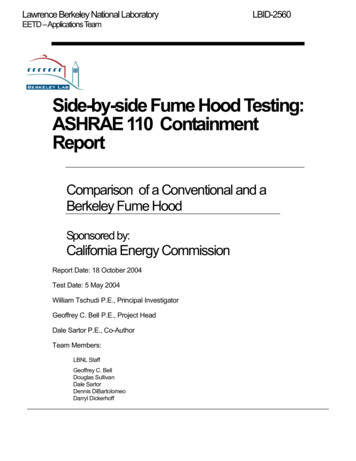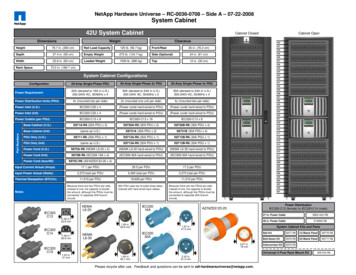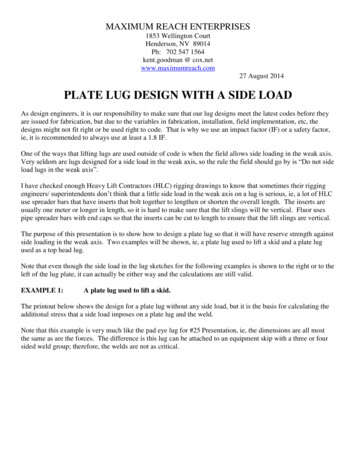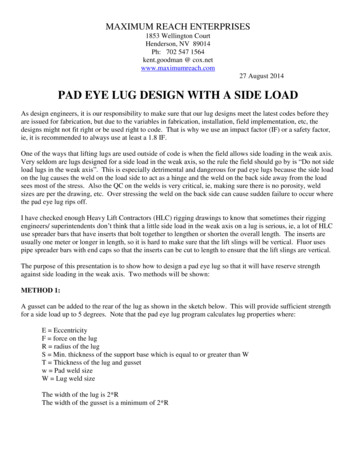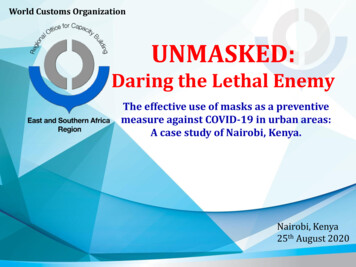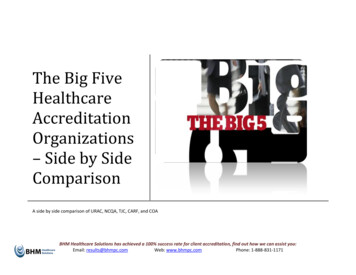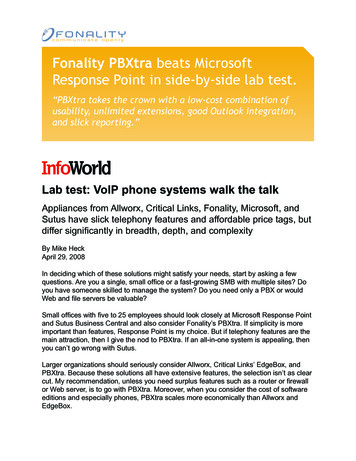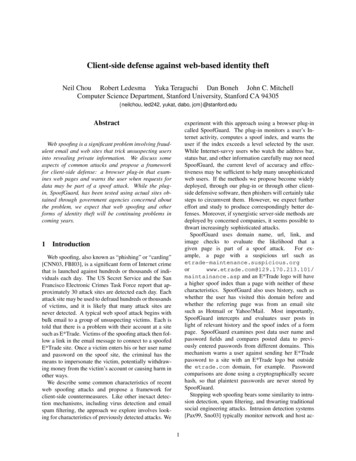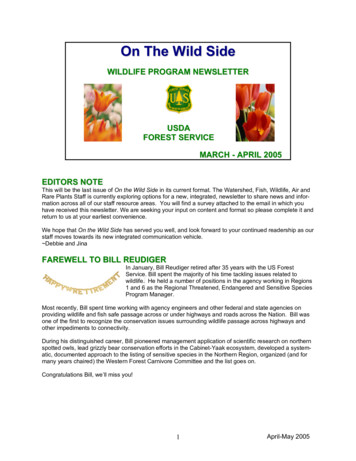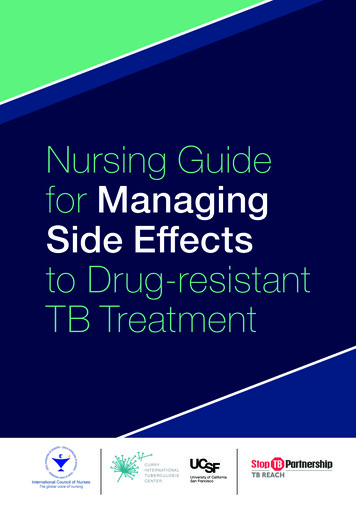
Transcription
Nursing Guidefor ManagingSide Effectsto Drug-resistantTB Treatment
This publication was made possible through a collaboration of the InternationalCouncil of Nurses (ICN) TB/MDR-TB Project and the Curry International Tuberculosis Center (CITC) at the University of California, San Francisco (UCSF).The ICN TB/MDR-TB Project is supported by a United Way Worldwide grant madepossible by the generosity of the Lilly Foundation on behalf of the Lilly MDR-TBPartnership. The further development, pilot-testing, production, design, translationand dissemination of this Nursing guide for managing side effects to drug-resistantTB treatment is supported by the Stop TB Partnership’s TB REACH initiative and isfunded by the Government of Canada and the Bill & Melinda Gates Foundation.Nursing guide for managingside effects to drug-resistantTB treatmentCITC/UCSF is funded through Centers for Disease Control and Prevention (CDC)Cooperative Agreement NU52PS910163-01-00 which has supported the development, production, design and US distribution of this guide in partnership with ICN.The views expressed in written materials or publications do not necessarily reflectthe official policies of the Department of Health and Human Services, nor does themention of trade names, commercial practices, or organizations imply endorsementby the U.S. Government.Field testing of this guide in Tanzania and Indonesia as well as translation into BahasaIndonesia were funded by the Global Health Bureau, Office of Infectious Disease,US Agency for International Development (USAID) through Challenge TB under theterms of Agreement No. AID-OAA-A-14-00029 and in partnership with the KNCVTuberculosis Foundation and the American Thoracic Society. This contribution to theguide is made possible by the generous support of the American people through USAID. The contents of this guide do not necessarily reflect the views of USAID or theUnited States Government.All rights, including translation into other languages, reserved. This work may bereprinted and redistributed, in whole or in part, without alteration and without priorwritten permission, provided the publication is properly cited.Suggested citation: International Council of Nurses and Curry International Tuberculosis Center. Nursing guide for managing side effects to drug-resistant TB treatment. Geneva. 2018.This product is available online at the following websites: www.icn.ch/what-we-do/projects/tbmdr-tb-project www.currytbcenter.ucsf.edu/productsISBN: 978-92-95099-53-1Design: Edi Berton Design www.ediberton.com2N U R S I N G G U I D E F O R M A N A G I N G S I D E E FF E C T S T O D R U G - R E S I S TA N T T B TR E AT M E N T2018 EditionAuthorsAnn Raftery, MS, BSN, RNCurry International Tuberculosis Center, University of California,San Francisco, San Francisco, CA, USACarrie Tudor, PhD, MPH, BSN, RNInternational Council of Nurses, Geneva, SwitzerlandLisa True, MS, RNCurry International Tuberculosis Center, University of California,San Francisco, San Francisco, CA, USACatalina Navarro, BSN, RNHeartland National Tuberculosis Center, San Antonio, TX, USAN U R S I N G G U I D E F O R M A N A G I N G S I D E E FF E C T S T O D R U G - R E S I S TA N T T B TR E AT M E N T3
Table of ContentsAcknowledgementsThe authors of this guide wish to thank and acknowledge the contributionsof those who provided incredible assistance in the development and piloting of the guide. The first iteration was field tested in 11 countries by morethan 200 nurses who used the guide and provided us with invaluablefeedback. We would like to thank the following individuals and organizations for their assistance in coordinating the field tests: Russian NursesAssociation (Ms Natalia Serebrennikova and Ms Tatiana Fedotkina), ChinaNursing Association and Peking Union Medical College School of Nursing(Dr Zhao Hong and Dr Guo Aimin), Indonesia (National TB Program andChallenge TB KNCV Indonesia with Dr Astuti Nursasi ), South Africa (MsSharon Fynn), Ghana National TB Control Programme ( Dr Nii Nortey Hanson-Nortey), Zambia (Mr Jojo Mulenga Moyo), Thailand National TB Program (Dr Sirinapha Jittimanee), Uganda (Ms Namuyodi Damalie Waiswa),US-Mexico TB Binational Projects (Ms Catalina Navarro) and USA (MsLisa True).The guide was translated into five languages for use in the pilot. We wouldlike to acknowledge Ms Elena Ploetz and the Russian Nurses Association’sTB Nurse Network for translation of the guide into Russian, Dr Zhao Hongand Dr Guo Aimin of the Peking Union Medical College School of Nursingfor translation of the guide into Chinese, Ms Catalina Navarro of the Heartland National Tuberculosis Center for translation of the guide into Spanish,Ms Baby Djojonegoro of the American Thoracic Society and the Indonesian DR-TB Nurses Workgroup for translation of the guide into BahasaIndonesia, Mr Fernando Augusto Dias e Sanches of the Thorax DiseaseInstitute, Federal University of Rio de Janeiro for translation into Portuguese, and Dr Sirinapha Jittimanee with the Thailand National TB Programfor translation of the guide into Thai.Last, but not least, we wish to provide thanks to the more than 200 frontline nurses caring for DR-TB patients who used the guide and providedus with very thoughtful feedback. We created this guide for you and for allnurses providing care and treatment to DR-TB patients around the world.Thank you for all you do to improve the care of patients.4N U R S I N G G U I D E F O R M A N A G I N G S I D E E FF E C T S T O D R U G - R E S I S TA N T T B TR E AT M E N TAbbreviations . . . . . . . . . . . . . . . . . . . . . . . . . . . . . . . . . . . . . . . . 6Introduction. . . . . . . . . . . . . . . . . . . . . . . . . . . . . . . . . . . . . . . . . . 8Gastrointestinal. . . . . . . . . . . . . . . . . . . . . . . . . . . . . . . . . . . . . . 11Nausea and Vomiting . . . . . . . . . . . . . . . . . . . . . . . . . . . . . . 12Gastritis . . . . . . . . . . . . . . . . . . . . . . . . . . . . . . . . . . . . . . . . 14Diarrhea. . . . . . . . . . . . . . . . . . . . . . . . . . . . . . . . . . . . . . . . 16Hepatoxicity . . . . . . . . . . . . . . . . . . . . . . . . . . . . . . . . . . . . . . . . 19Musculoskeletal . . . . . . . . . . . . . . . . . . . . . . . . . . . . . . . . . . . . . 23Fatigue . . . . . . . . . . . . . . . . . . . . . . . . . . . . . . . . . . . . . . . . . . . . 27Neurological . . . . . . . . . . . . . . . . . . . . . . . . . . . . . . . . . . . . . . . . 31Optic Neuritis. . . . . . . . . . . . . . . . . . . . . . . . . . . . . . . . . . . . 32Vestibular and Ototoxicity . . . . . . . . . . . . . . . . . . . . . . . . . . . 34Peripheral Neuropathy. . . . . . . . . . . . . . . . . . . . . . . . . . . . . . 36Depression. . . . . . . . . . . . . . . . . . . . . . . . . . . . . . . . . . . . . . 38Psychosis. . . . . . . . . . . . . . . . . . . . . . . . . . . . . . . . . . . . . . . 40Headache. . . . . . . . . . . . . . . . . . . . . . . . . . . . . . . . . . . . . . . 42Seizure. . . . . . . . . . . . . . . . . . . . . . . . . . . . . . . . . . . . . . . . . 44Hematological. . . . . . . . . . . . . . . . . . . . . . . . . . . . . . . . . . . . . . . 47Anemia. . . . . . . . . . . . . . . . . . . . . . . . . . . . . . . . . . . . . . . . . 48Thrombocytopenia . . . . . . . . . . . . . . . . . . . . . . . . . . . . . . . . 50Renal Toxicity . . . . . . . . . . . . . . . . . . . . . . . . . . . . . . . . . . . . . . . 53Acute Renal Failure. . . . . . . . . . . . . . . . . . . . . . . . . . . . . . . . 54Electrolyte Disturbances . . . . . . . . . . . . . . . . . . . . . . . . . . . . 56Endocrine . . . . . . . . . . . . . . . . . . . . . . . . . . . . . . . . . . . . . . . . . . 59Hypothyroidism. . . . . . . . . . . . . . . . . . . . . . . . . . . . . . . . . . . 60Dysglycemia . . . . . . . . . . . . . . . . . . . . . . . . . . . . . . . . . . . . 62Cardiac . . . . . . . . . . . . . . . . . . . . . . . . . . . . . . . . . . . . . . . . . . . . 65QTc Prolongation . . . . . . . . . . . . . . . . . . . . . . . . . . . . . . . . . 66Hypersensitivity. . . . . . . . . . . . . . . . . . . . . . . . . . . . . . . . . . . . . . 69Rash. . . . . . . . . . . . . . . . . . . . . . . . . . . . . . . . . . . . . . . . . . . 70Anaphylaxis . . . . . . . . . . . . . . . . . . . . . . . . . . . . . . . . . . . . . 72Hypersalivation. . . . . . . . . . . . . . . . . . . . . . . . . . . . . . . . . . . . . . 75References . . . . . . . . . . . . . . . . . . . . . . . . . . . . . . . . . . . . . . . . . 78Appendix A: Pain Assessment Method . . . . . . . . . . . . . . . . . . . 80Appendix B: PHQ-9 Depression Screening Tool . . . . . . . . . . . . 82Appendix C: Peripheral Neuropathy Evaluation Tool. . . . . . . . . 86Appendix D: Side Effect Monitoring Checklist. . . . . . . . . . . . . . 88N U R S I N G G U I D E F O R M A N A G I N G S I D E E FF E C T S T O D R U G - R E S I S TA N T T B TR E AT M E N T5
ateINSTIsIntegrase strand transfer udineKmKanamycinBdqBedaquilineLFTLiver function testBMIBody mass indexLfxLevofloxacinBUNBlood urea leoside reverse transcriptase inhibitorsCNSCentral Nervous SystemNSAIDsNon-steroidal anti-inflammatory drugsCBCComplete blood lic acidd4TStavudinePIsProtease inhibitorsddIDidanosinePQRSTDlmDelamanidPain assessment method( Precipitating, Quality, Region/radiation, Severity, Temporal / timing )DR-TBDrug-resistant lpivirineEto/PtoEthionamide/ mycinGfxGatifloxacinSQV and SQV/rSaquinavir and HctHematocritTPV and TPV/rTipranavir and im/ sulfamethoxazole (Bactrim)HgbA1CBlood test used to diagnose diabetes and how well one’s diabetes iscontrolled; this test provides the 8 – 12 week average blood glucose.TrdTerizidoneTSHThyroid-stimulating hormoneN U R S I N G G U I D E F O R M A N A G I N G S I D E E FF E C T S T O D R U G - R E S I S TA N T T B TR E AT M E N TN U R S I N G G U I D E F O R M A N A G I N G S I D E E FF E C T S T O D R U G - R E S I S TA N T T B TR E AT M E N T7
IntroductionPatients on treatment for drug-resistant tuberculosis (DR-TB) face many challenges,most notably difficult side effects such as nausea, hearing loss and fatigue thatmay impact the patient’s quality of life, capacity to work and ability to continue activities of daily living. Recent studies have identified medication side effects as a majorfactor for patients stopping treatment prematurely. The 2017 WHO Global TB Reportnoted a continued crisis related to treatment outcomes for drug-resistant TB withonly 54% of patients successfully completing treatment in 2014.Nurses are frequently the first point of contacta patient will have when seeking health careand are the main cadre of health professionalsworldwide delivering and/or overseeing apatient’s daily directly observed treatment.How Information is OrganizedThe guide is organized into the major types of toxicities, the associated symptoms, possible offending medications, and the suggested nursing assessments and interventions. Some symptoms ( e.g. nausea) may be associatedwith a number of underlying causes and may be mild, or a symptom of amore serious medical situation requiring urgent attention. The pathophysiology for medication-related fatigue and hypersalivation are unclear and thesesymptoms are not grouped under a specific type of toxicity. Additional information (comments) are provided for each toxicity to highlight relevant clinical information that may assist in management of side effects. Medications morestrongly associated with the side effect appear in bold text. The appendicesinclude tools nurses can use to more thoroughly assess patient complaints ofpain, depression and neuropathy.How to Use the GuideNurses are often the first to hear of a patient’s side effect(s) during TB treatment andtherefore, are well positioned to intervene. In response to requests from nurses foradditional nursing practice resource tools, this guide was developed to help nursesassess for and respond appropriately to side effects related to anti-TB medications.The guide is designed as a reference so nurses can quickly:1. Identify symptoms that may indicate an anti-TB or anti-retroviralmedication-related side effect;2. Assess for severity as well as other potential contributors; and3. Intervene appropriately to minimize patient discomfort, reduce sideeffect progression, and ultimately support successful treatmentcompletion.This guide was developed by nurses with experience in the clinical care and programmatic management of TB and DR-TB in both high- and low-resource settings. Nursingand DR-TB literature were reviewed to establish best practice nursing assessmentand intervention guidance. Nurses caring for patients with DR-TB field tested the job aidand provided feedback which was used to inform final content and format.8N U R S I N G G U I D E F O R M A N A G I N G S I D E E FF E C T S T O D R U G - R E S I S TA N T T B TR E AT M E N TThe guide is a practical resource for nurses in inpatient, clinic and communitysettings and may be used in conjunction with local protocols. Some assessments and interventions may not be available or within the scope of practicein all settings; nurses should refer to local protocols when available to guidedecision-making. The scope of this guide is limited to address management ofmedication-related side effects and does not address management of symptoms due to the disease itself or other important aspects of nursing care (suchas addressing barriers to adherence). Additionally, the guide does not replacethe need for training and mentoring for nurses caring for patients with DR-TB.We encourage our nurse colleagues to continue to identify gaps in resourceand training materials so that we can work to address the needs. Please contact the authors if you have questions.N U R S I N G G U I D E F O R M A N A G I N G S I D E E FF E C T S T O D R U G - R E S I S TA N T T B TR E AT M E N T9
Nausea and VomitingGastritisDiarrhea10N U R S I N G G U I D E F O R M A N A G I N G S I D E E FF E C T S T O D R U G - R E S I S TA N T T B TR E AT M E N TGastrointestinalNotes11
SymptomsNausea and/orvomitingPossible dqNVPInhand mostothersEmbPzaAmx /ClvCfzDlmLzdCs / TrdNursing AssessmentNursing InterventionsObserve for signs of:Seek urgent medical evaluation when signs of hepatitis, GI bleeding ordehydration are observed. Hepatitis (fatigue, abdominal pain, yellowingof eyes and skin) GI bleeding (vomit with red blood or “coffeeground” appearance, abdominal pain,dizziness) Dehydration (dry/tenting of skin, sunkeneyes, decreased urination, confusion)Ask the patient: What medicines are you taking? When does the nausea or vomiting start?Counsel the patient: Some nausea and vomiting is expected early in DR-TB treatment but willdecrease over time Nutrition support strategies (e.g., good hydration; small, frequent meals; gingerdrinks or sweets may help) Relaxation techniques or other comfort measuresWhen nausea and/or vomiting is considered troublesome to the patient,discuss with the doctor: How often do you experience the nauseaand/or vomiting and how long does it last? Anti-emetic* 30 min. before DR-TB medication What makes it better or worse? Timing of suspect medication dose (larger dose at bedtime or different time of day) How is your appetite? Anti-anxiety medication for anticipatory nausea What have you had to eat/drink today? Whether oral or IV rehydration needed if patient shows signs of dehydration If vomiting, describe color and consistency Whether electrolyte replacement is indicated Slow ramping up of suspect medication (Eto/Pto, PAS)If significant vomiting, check: Vital signs, serum electrolytes and creatinineComments If febrile, refer for medical evaluationNausea and/or vomiting may also occur with: 12NAUSEA & VOMITINGGastrointestinal / Nausea & VomitingN U R S I N G G U I D E F O R M A N A G I N G S I D E E FF E C T S T O D R U G - R E S I S TA N T T B TR E AT M E N TAcute viral illnessHepatitisGastritis or peptic ulcerPancreatitisDisease of the gall bladderDisease of the bile ductsLactose intoleranceAcute renal failureAlcohol withdrawalDiabetic gastroparesisPregnancyBowel obstructionCNS TBPsychological factors (e.g., anxiety)Patients with diabetes may have betterresults with promotility medication (e.g.,metroclopramide).Note:*If patient is taking Bdq or Dlm,do not give ondanestron as ananti-emetic as it mayprolong QTc.N U R S I N G G U I D E F O R M A N A G I N G S I D E E FF E C T S T O D R U G - R E S I S TA N T T B TR E AT M E N T13
GASTRITISGastrointestinal / GastritisSymptomsOne or more of thefollowing symptoms:Pain or burningsensation inabdomen oresophagusSour taste inmouthBloatingNursing AssessmentNursing InterventionsObserve for signs of:Seek urgent medical evaluation when signs of hepatitis or GI bleeding (presenceof blood in vomit or stool) are observed. Hepatitis (fatigue, abdominal pain, yellowingof eyes and skin) GI bleeding (blood in vomit or stool)Ask the patient:Anti-TB:ARVs:PASMost ARVs Gastritis is a common side effect of DR-TB treatment and can be treated What medicines are you taking? Try eating small, frequent meals. Avoid food and drink that may make symptomsworse (e.g., alcohol, caffeine, spicy, acidic, high fat) When do the symptoms occur? Try relaxation and/or distraction techniques How long does it last? What makes it better or worse?Possible OffendingMedicationsCounsel the patient:When gastritis is troublesome, discuss with the doctor: How is your appetite? Whether use of adjuvant medication (H2-blocker or proton-pump inhibitor)may help What have you had to eat/drink today? Minimize or discontinue use of NSAIDsCheck for symptoms of gastritis (epigastricburning, sour taste in mouth, abdominaldistention or bloating)Eto/PtoCfzFQs (Lfx, Mfx)InhEmb Starting an antacid; NOTE: antacids must be taken 2 hours before or afterTB medicationsCommentsSymptoms are often worse in the morning orprior to eating. Patients who take nonsteroidalanti-inflammatory drugs (NSAIDs) or drink a lotof alcohol are at increased risk.Abdominal pain is a common side effect ofARVs.Abdominal pain can also occur with pancreatitis,lactic acidosis, infection with H. pylori andpeptic ulcer.PzaCfz has been associated with severe abdominaldistress. In such cases, Cfz should be stopped.If patient is taking the short DR-TB regimenwhich includes Cfz and must stop due to thisadverse effect, the patient no longer qualifies tocomplete the shorter regimen and must switchto an alternative DR-TB regimen.14N U R S I N G G U I D E F O R M A N A G I N G S I D E E FF E C T S T O D R U G - R E S I S TA N T T B TR E AT M E N TN U R S I N G G U I D E F O R M A N A G I N G S I D E E FF E C T S T O D R U G - R E S I S TA N T T B TR E AT M E N T15
DIAR
and Dr Guo Aimin of the Peking Union Medical College School of Nursing for translation of the guide into Chinese, Ms Catalina Navarro of the Heart - land National Tuberculosis Center for translation of the guide into Spanish, Ms Baby Djo
